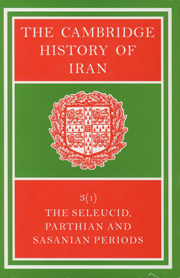Book contents
- Frontmatter
- Introduction
- PART 1 POLITICAL HISTORY
- 1 THE SELEUCID PERIOD
- 2 THE POLITICAL HISTORY OF IRAN UNDER THE ARSACIDS
- 3 IRANIANS IN ASIA MINOR
- 4 THE POLITICAL HISTORY OF IRAN UNDER THE SASANIANS
- 5 THE HISTORY OF EASTERN IRAN
- 6 THE POLITICAL HISTORY OF TRANSOXIANA
- 7 THE IRANIAN SETTLEMENTS TO THE EAST OF THE PAMIRS
- PART 2 NUMISMATICS
- PART 3 IRANIAN HISTORICAL TRADITION
- PART 4 IRAN AND HER NEIGHBOURS
- Bibliography
- Plate section
- Plate section
- Plate section
- Map 3. The western regions of the Sasanian empire">
- Map 11. The Silk Road from China to the Roman Orient
- References
1 - THE SELEUCID PERIOD
from PART 1 - POLITICAL HISTORY
Published online by Cambridge University Press: 28 March 2008
- Frontmatter
- Introduction
- PART 1 POLITICAL HISTORY
- 1 THE SELEUCID PERIOD
- 2 THE POLITICAL HISTORY OF IRAN UNDER THE ARSACIDS
- 3 IRANIANS IN ASIA MINOR
- 4 THE POLITICAL HISTORY OF IRAN UNDER THE SASANIANS
- 5 THE HISTORY OF EASTERN IRAN
- 6 THE POLITICAL HISTORY OF TRANSOXIANA
- 7 THE IRANIAN SETTLEMENTS TO THE EAST OF THE PAMIRS
- PART 2 NUMISMATICS
- PART 3 IRANIAN HISTORICAL TRADITION
- PART 4 IRAN AND HER NEIGHBOURS
- Bibliography
- Plate section
- Plate section
- Plate section
- Map 3. The western regions of the Sasanian empire">
- Map 11. The Silk Road from China to the Roman Orient
- References
Summary
INTRODUCTION
Our knowledge of Seleucid Iran is unfortunately meagre. The scanty sources mostly record occurrences such as military campaigns, royal accessions and the like, and hardly give any information on economic or social matters. Even the isolated facts we speak of are almost all Greek; in Seleucid Iran, as we know it, the Iranians are not seen or heard. The reasons for these deficiencies are historical.
Memory is selective; succeeding generations remember what is relevant to their own life and forget the rest: “Let the dead bury their dead.” After the Romans had ended Seleucid rule in Syria in 63 B.C., nobody cared any longer for the defunct dynasty. Sycophants and historians alike now turned to the Caesars. The only extant Greek outline of Seleucid history is appended to the narrative of the Roman conquest of Syria in Appian's “History of Rome”, compiled in the 2nd century A.D.
As for the Iranians, they lost the memory of their remote past. Whereas after the Arab conquest the Zoroastrian priests and native gentry endeavoured to keep alive the Persian tradition and to preserve religious writings and the glory of the Sasanians, the pre-Sasanian past receded into the realm of fable, and Alexander himself became “the king of Rūm”, that is, of Byzantium. When Bīrūnī collected (c. A.D. 1000) “The Vestiges of Past Generations” (al-Āthār al-bāqiya), he learned of Cyrus only from Jewish (Christian) sources, where the founder of the Persian monarchy was remembered as a friend of the Chosen People.
Keywords
- Type
- Chapter
- Information
- The Cambridge History of Iran , pp. 1 - 20Publisher: Cambridge University PressPrint publication year: 1983
References
- 4
- Cited by



